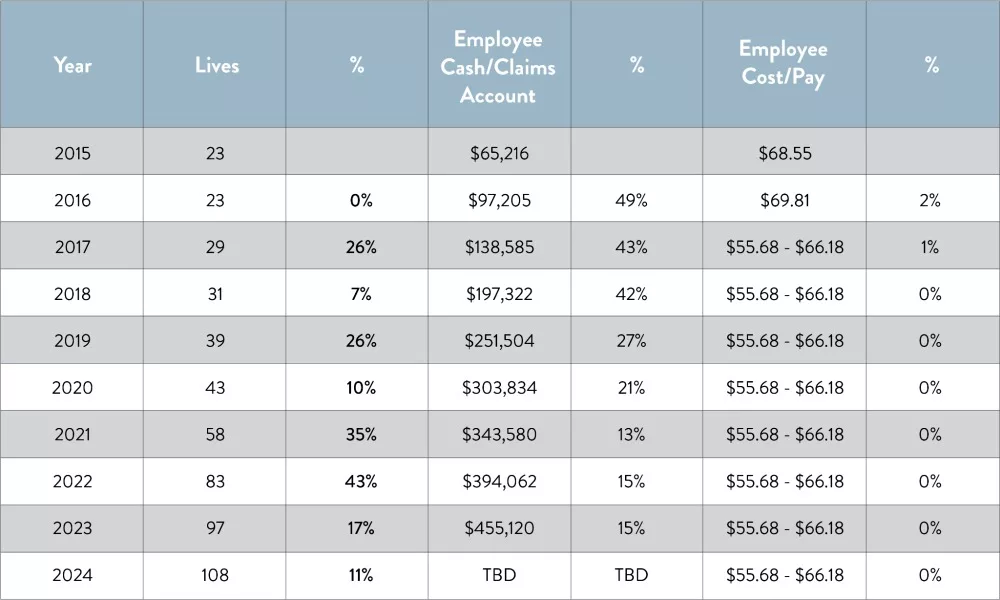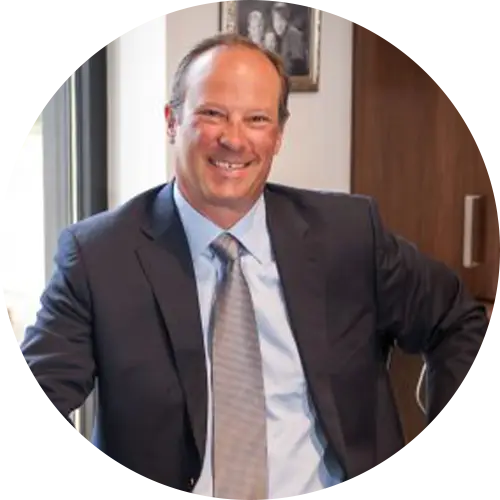Just as a sturdy house requires a strong foundation, solid walls, and a protective roof, a robust health insurance plan requires strategic planning, a strong but flexible design, and good maintenance strategies. This analogy perfectly illustrates Roundstone’s journey when we transitioned to our own self-funded group captive plan.
From 2009 to 2019, healthcare costs skyrocketed by 30%, making health insurance increasingly unaffordable for many small to midsize businesses. It’s a trend that’s spiraling out of control — healthcare costs continue to get more expensive.
Traditional insurance providers continually raised premiums every year, but we found a way to buck this trend. Eight years ago, we made the switch from traditional, fully funded insurance to our own self-funded insurance plan.
The result? Roundstone employees have seen no premium increase for 8 consecutive years. What’s more, we have been able to stabilize healthcare expenses, a feat that defies the industry trend — all while growing the company and providing tailored, high-quality benefits to our employees.

Through participation in our own self-funded group captive, Roundstone employees have seen no meaningful increase in their premium contribution for 8 straight years.
Here’s how we did it.
Laying the Foundation: Roundstone’s Transition to Self-Funded Insurance
Established in 2003, we set out to help companies secure affordable small business health insurance through self-funding within a group captive insurance model. President and Founder Mike Schroeder spearheaded this approach, empowering organizations to band together to share the risk by forming a self-insured group medical captive.
When our employee count reached 35, the yearly premium increases of our fully insured carrier became untenable. This prompted leadership to transition the company to one of our own self-funded group captive plans. This strategic move allowed us to take control of our healthcare expenses, leading to cost control, plan customization, and substantial savings.
According to Mike: “We were like a lot of smaller middle market companies in that we were buying fully insured, major medical coverage from one of the traditional names you hear about — Anthem, United Healthcare, and so on. We were keeping an eye on our employee count to see when we would be big enough, in our minds, to do this. When we reached, I think it was, 35 employees, and we were consistently receiving double-digit increases, that’s when we decided to switch into self-funding with the captive model.”
As a result, over the past five years, Roundstone has seen cumulative savings of $1,132,950.
Building the Walls: A Strong Yet Flexible Plan Design
Just as the walls of a house provide the necessary structure and support while allowing for flexibility within its rooms, so too does our approach to plan design in our self-funded insurance model.
In crafting our self-funded plan, we successfully addressed the healthcare needs of all our employees through a flexible plan design. We are able to provide a traditional HDHP with a $3,000 deductible and a contribution to an HSA, while using claims data to tweak the plan as needed to ensure excellent coverage and cost.
We also introduced a wellness program that incentivized employees to improve their health, offering premium contribution reductions for participants. Because of this, some Roundstone employees who participate in the wellness programs actually pay less now than they did eight years ago. Participation in the wellness program can reduce employee share of premiums by $15/paycheck, up to 10% of the employee contribution.
Choosing the Right Materials: Selecting a TPA for Your Self-Funded Insurance Plan
Choosing the right partners for a self-insured health plan is just as crucial as choosing the right materials when building a home. We began with the selection of a reliable Third-Party Administrator (TPA) and Pharmacy Benefits Manager (PBM).
We chose to work with Bywater, our in-house TPA, because they’re known for handling self-funded claims with transparency and a customer-centric approach. This careful selection process laid a strong foundation for our self-funded healthcare plan, resulting in a smooth claims experience and company-wide savings.
We were equally thoughtful in choosing our PBM. Traditional PBMs operate on a “spread pricing” model, meaning they keep a portion of the funds rather than passing them on to the employer. This, along with a general lack of transparency, makes it challenging for companies to fully understand their drug costs and potential savings. It also results in substantially more expensive healthcare.
We chose to work with a transparent PBM instead, who passes savings on to us and we strongly recommend the same for our clients. It’s your money – you should be able to keep it.
Adding the Roof: Reinvesting Surplus Funds of a Self-Funded Insurance Plan

A unique advantage of a self-funded insurance plan is the potential for excess funds when claims are lower than expected. At Roundstone, we’ve used this advantage strategically — we made a commitment to reinvest surpluses from the claims account back into our employee benefits plan.
This has allowed us to provide additional benefits, reduce out-of-pocket expenses for employees, and keep employees’ cost share obligations stable for the last 8 years.
Roundstone carries this approach forward with all group captive members. Since our inception 20 years ago, we have returned an impressive $72 million in unspent premium to captive members, effectively cushioning the impact of rising healthcare costs.
Maintaining the Structure: Cost Saving Strategies
Like a well-kept home, a self-funded insurance plan needs maintenance and care. Our solution involves three key strategies that have helped us establish a strong and resilient healthcare solution: data transparency, consistent review, and strategies to control prescription drug prices.
The Role of Data Transparency in the Savings of a Self-Funded Plan
Data transparency has played a pivotal role in the success of our self-funded plan. Having a clear understanding of where healthcare dollars are being spent allows us to make informed decisions about areas of the plan that need adjustment or improvement.
To make that happen, we created the innovative CSI Dashboard, a platform that provides transparent access to comprehensive claims data. This enables our company to track plan performance, analyze trends, and compare our results to industry benchmarks. We have also made the CSI Dashboard and CSI Team available to all members of our captive.
The Importance of Consistent Review
Regular reviews are another important factor in our cost savings strategy. We conduct annual reviews of our vendor partnerships to ensure they continue to provide the best value. This proactive approach allows us to identify areas for improvement, refine our plan, and implement cost containment strategies for extra savings.
Regular review also gives us the opportunity to refine and expand our well-being program, continually tailoring it to meet the evolving needs of our employees. This has led to improved health outcomes and cost savings as healthier employees typically generate lower healthcare costs.
Tools to Combat Inflation and Rising Pharmacy Costs

In addition to the ability to identify cost saving opportunities through the CSI Dashboard, self-funding has allowed us to tackle inflation and escalating prescription drug costs through the use of a transparent PBM.
Pass-through and transparent PBMs offer transparency regarding medication costs, pass rebates directly to our captive, and eliminate the spread pricing often associated with traditional PBMs.
As a result, we’re able to negotiate directly with drug manufacturers, access competitive pricing, and pass the savings along to our employers and employees. By sidestepping traditional PBM structures, we’ve been able to reduce the impact of inflation and rising pharmacy costs, delivering cost savings to plan members.
Self-Funded Health Insurance: A Path to a Better Life for All
Roundstone’s self-funding approach has facilitated company growth while providing cost-effective healthcare for all employees. We extend this opportunity to all small and midsize businesses, offering smaller companies and their employees access to quality, affordable healthcare.
In fact, the average small to midsize business in the Roundstone Captive saves 20% over their traditional insurance plan.
We are so confident that your company will save money that we’re proud to offer the Roundstone Guarantee — you will save money in the first 5 years or we will make up the difference.
Experience the Self-Funding Difference
Roundstone’s self-funding approach has allowed our company to continue to grow while providing cost-effective healthcare for all employees.
Says Chad Buskirk, Roundstone’s Chief Accounting Officer, “Our journey and the lessons we’ve learned can serve as a guide for others navigating the complexities of self-funded healthcare. By starting with a solid foundation, continually evaluating and improving, and putting employees’ well-being at the forefront, organizations can achieve sustainable and cost-effective healthcare solutions.”
To learn more about Roundstone’s success with its own self-funding model, read the full case study and discover how our innovative healthcare solution can contribute to a better life for all.
Learn More About Self-Funding with Roundstone
If you’re ready to stop overpaying on premiums and get customized healthcare coverage for your employees, it’s time to consider self-funding. Discover the difference that a self-funded health insurance plan with Roundstone can make for your business. Contact us today for a free quote and benchmark review.










